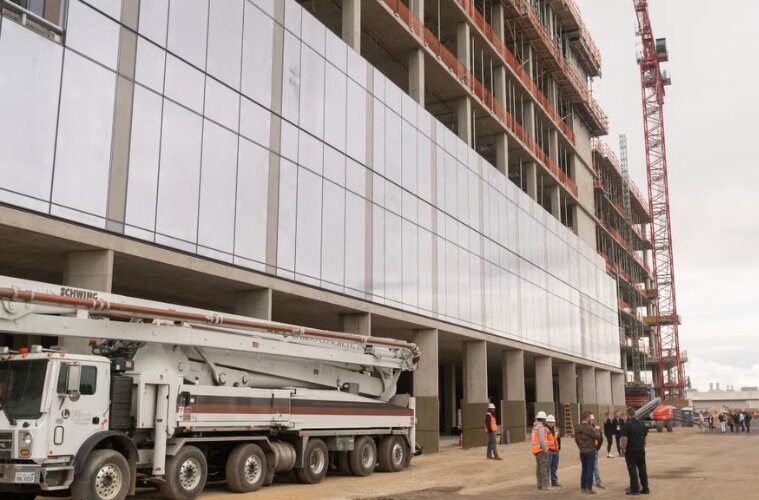
The idea of using building materials to store carbon is gaining momentum, offering a potential solution to reduce greenhouse gas emissions.
A recent study published in Science highlights how this approach could help sequester billions of tonnes of CO2 annually.
The study suggests that replacing conventional materials with carbon-storing alternatives could store up to 16.6 billion tonnes of CO2 per year, or about 50% of global emissions in 2021.
Companies worldwide are leading this effort by innovating sustainable materials.
>> RELATED: Revolutionizing Construction: The Rise of Bio-based and Sustainable Building Materials for a Greener Future

Companies Pioneering Carbon-Storing Technologies
Several companies are exploring ways to integrate carbon storage into widely used materials such as concrete, bricks, and plastics. These organizations are at the forefront of creating solutions that could revolutionize the construction industry.
Alternative Cement Solutions
Concrete production contributes significantly to global emissions, but companies are rethinking its composition to make it carbon-negative. For instance:
Solidia Technologies is working on a cement that uses CO2 during the curing process, reportedly cutting emissions by up to 70% compared to traditional methods.
Carbon Upcycling uses captured CO2 to create additives for cement, enhancing strength while reducing the material's carbon footprint.
These innovations address both the carbon-intensive production of cement and its potential as a carbon sink.
Carbon-Negative Aggregates
Aggregates used in concrete and asphalt present another opportunity for carbon storage.
Companies like Blue Planet and O.C.O. Technology focus on synthetic carbonate aggregates.
These materials combine industrial waste with CO2 to create building components that are not only sustainable but also carbon-negative.
Advances in Bioplastics
The demand for sustainable plastics is driving innovation in bioplastics.
Companies like Braskem and Biovyn produce bio-based polyethylene and polyvinyl chloride, respectively.
These materials reduce dependency on fossil fuels and can integrate carbon derived from biomass, offering a more sustainable alternative.
Biomass-Based Bricks
Bricks made from biomass are gaining traction as another way to store carbon. For example:
Orbix creates bricks using calcium carbonate derived from industrial by-products.
Just Biofiber incorporates hemp and other organic materials, combining them with mineralization techniques to produce carbon-storing building blocks.
These bricks not only sequester carbon but also utilize waste materials, enhancing their environmental value.
Bio-Based Asphalt Alternatives
Replacing petroleum-based asphalt with bio-oil alternatives is another promising development.
Avello Bioenergy is developing bio-asphalt binders from agricultural residues. Similarly, Avantium has partnered with infrastructure companies to implement lignin-based bio-asphalt, reducing emissions by up to 60%.

>> In Other News: Green Plains Announces 100% of Rights of Way Acquired on ‘Advantage Nebraska’ Carbon Capture Project with Lateral Construction Underway
The Broader Implications of Carbon-Storing Materials
The study emphasizes that building materials could act as long-term carbon reservoirs.
As ELISABETH VAN ROIJEN notes, “Building materials could store more than 16 billion tonnes of CO2 annually,” underscoring the vast potential of this approach.
SABBIE A. MILLER, one of the study’s authors, highlights how modest adjustments in material composition could lead to transformative climate benefits.
While these innovations are promising, scaling them remains a challenge.
Many companies are still in the pilot or prototype stages, hindered by cost barriers and the conservative nature of the construction industry. However, the demand for sustainable materials is growing, driven by policy incentives and a push for decarbonization.
Policy and Market Drivers
Regulatory frameworks and market demand play crucial roles in advancing these technologies.
Initiatives like the European Green Deal and California’s net-zero cement legislation create opportunities for these innovations to thrive.
Additionally, companies exploring carbon storage solutions are likely to benefit from partnerships with governments and industries seeking sustainable alternatives.
The Road Ahead
The potential of carbon-storing materials to mitigate climate change is undeniable.
Collaboration between companies, governments, and research institutions will be key to overcoming barriers and scaling these technologies.
With further investment and innovation, the built environment could become a significant carbon sink, reducing the need for other costly storage methods like geological sequestration.
To learn more about this groundbreaking study, you can access it directly at Science.org.
Subscribe to the newsletter
Daily decarbonization data and news delivered to your inbox
Follow the money flow of climate, technology, and energy investments to uncover new opportunities and jobs.
Companies
Latest issues
-
The Deal Structure Everyone's About to Copy
Inside This Issue 💼 The Deal Structure Everyone's About to Copy 📈 Exxonmobil Raises Its 2030 Plan – Transformation Delivering Higher Earnings, Stronger Cash Flow, and Greater Returns ⚡ Nextera Wor...
-
Inside XCF Global's $300M Bet to Double U.S. SAF Output
Inside This Issue ✈️ Inside XCF Global's $300M Bet to Double U.S. SAF Output ⚙️ Capsol Technologies Signs MoU with US Utility to Deploy CapsolGT® for Low-carbon Gas Power Generation 🏭 Babcock &...
-
64 Carbon Projects Were Stuck. Texas Just Unlocked Them
Inside This Issue 🛢️ 64 Carbon Projects Were Stuck. Texas Just Unlocked Them ⚙️ In Ohio, Hydrogen Industry Presses on Despite Federal Uncertainty 🧲 Agami Zero Breaks Through With Magnetic Hydrogen...
Company Announcements
-
Elemental Clean Fuels Powers Kamloops' Largest Green Hydrogen Initiative
KAMLOOPS, BC, Dec. 10, 2025 /CNW/ — Elemental Clean Fuels (ECF) is partnering with Sc.wén̓wen Economic Development and Kruger Kamloops Pulp L.P. to advance the Kamloops Clean Energy Centre (KCEC), ...
-
SYDNEY, NS, Dec. 10, 2025 /CNW/ — alterBiota, a Canadian cleantech company developing solutions to modernize and decarbonize concrete, announced that its flagship product, deltaC (∆C™), has officia...
-
TORONTO, Dec. 10, 2025 (GLOBE NEWSWIRE) — CHAR Technologies Ltd. (“CHAR Tech” or the “Company”) (TSXV:YES), a leader in sustainable energy solutions, is pleased to announce that the Government of O...
-
Increases of $5 billion in earnings and cash flow growth at constant prices and margins vs. prior plan with no capital spending increase. Cumulative structural cost savings plan increased by $2 bi...